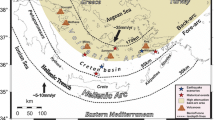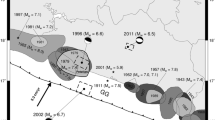Abstract
We attempt to model the spatial distribution of the strong ground motion for the large M = 7.0, 1954 Sofades and M = 6.8, 1957 Velestino events (southern Thessaly basin, central Greece), using the macroseismic intensities (I M M up to 9+) observed within the broader Thessaly area. For this reason, we employ a modified stochastic method realised by the EXSIM algorithm for extended sources, in order to reproduce the damage distribution of these earthquakes, in an attempt to combine existing earthquake information and appropriate scaling relations with surface geology and to investigate the efficiency of the available macroseismic data. For site-effects assessment, we use a new digital geological map of the broader Thessaly basin, where geological formations are grouped by age and mapped on appropriate NEHRP soil classes. Using the previous approach, we estimate synthetic time series for different rupture scenarios and employ various calibrating relations between PGA/PGV and macroseismic intensity, allowing the generation of synthetic (stochastic) isoseismals. Also, different site amplification factors proposed for the broader Aegean area, according to local geology, are tested. Finally, we also perform a sensitivity analysis of the fault location, taking into account the available neotectonic data for the broader southern Thessaly fault zone. The finally determined fault locations are different than previously proposed, in agreement with the available neotectonic information. The observed macroseismic intensities are in good agreement with the ones derived from the synthetic waveforms, verifying both the usefulness of the approach, as well as of the macroseismic data used. Finally, site-effects show clear correlation with the geological classification employed, with constant amplification factors for each soil class generally providing better results than generic transfer functions.













Similar content being viewed by others
References
Abrahamson NA, Silva WJ, Kamai R (2014) Summary of the ASK14 ground motion relation for active crustal regions. Earthq Spectra 30:1025–1055
Ambraseys NN, Jackson JA (1990) Seismicity and associated strain of central Greece between 1890 and 1988. Geophys J Int 101:663–708
Atkinson GM, Boore DM (1995) Ground-motion relations for eastern North America. Bull Seism Soc Am 85:17–30
Beresnev IA, Atkinson GM (1999) Generic finite-fault model for ground-motion prediction in eastern North America. Bull Seism Soc Am 89:608–625
Boore DM (1983) Stochastic simulation of high-frequency ground motions based on seismological models of the radiated spectra. Bull Seism Soc Am 73:1865–1894
Boore DM (2009). Comparing stochastic point-source and finite-source ground-motion simulations: SMSIM and EXSIM,Bull Seism Soc Am 99(6):3202–3216
Boore DM, Atkinson GM (1987) Stochastic prediction of ground motion and spectral response parameters at hard-rock sites in eastern north America. Bull Seism Soc Am 77:440–467
Boore DM, Joyner WB (1997) Site amplifications for generic rock sites. Bull Seism Soc Am 87:327-341
Boore DM, Stewart JP, Seyhan E, Atkinson GM (2014) NGA-West2 equations for predicting PGA, PGV, and 5 % damped PSA for shallow crustal earthquakes. Earthq Spectra 30:1057–1085
Campbell KW, Bozorgnia Y (2014) NGA-West2 ground motion model for the average horizontal components of PGA, PGV, and 5 % damped linear acceleration response spectra. Earthq Spectra 30:1087–1115
Caputo R, Pavlides S (1993) Late cainozoic geodynamic evolution of thessaly and surroundings (central-northern Greece). Tectonophysics 223(3):339–362
Chiou BS, Youngs RR (2014) Update of the Chiou and Youngs NGA model for the average horizontal component of peak ground motion and response spectra. Earthq Spectra 30:1117–1153
Ferrari G, Gasperini P, Guidoboni E (1995) Macroseismic intensity evaluation with the fuzzy sets logic. Annali di Geofisica 38(5-6):811–826
Klimis NS, Margaris BN, Koliopoulos PK (1999) Site-dependent amplification functions and response spectra in Greece. J Earthq Eng 3(02):237–270
Koliopoulos PK, Margaris BN, Klimis NS (1998) Duration and energy characteristics of Greek strong motion records. J Earthq Eng 2(3):391–417
Lekkas E (1987) Geological structure and geodynamic evolution of the Koziakas range (western Thessaly) (in Greek), PhD thesis, Department of Geology, National and Kapodestrian University of Athens
Margaris BN, Boore DM (1998) Determination of Δσ and κ0 from response spectra of large earthquakes in Greece. Bull Seism Soc Am 88:170182
Motazedian D, Atkinson GM (2005) Stochastic finite-fault modelling based on a dynamic corner frequency. Bull Seism Soc Am 95:991010
Mountrakis D, Kilias A, Pavlides S, Zouros N, Spyropoulos N, Tranos M, Soulakelis N (1993) Field study of the southern Thessaly highly active fault zone. In: Proceedings of the 2nd Congress of the Hellenic Geophysical Union, vol 2, p 603614
Ou GB, Hermann RB (1990) Estimation theory for peak ground motion. Seismol Res Lett 61(2):99–107
Panagiotopoulos DG, Papazachos CB (2008) Application of modern methods for assessing the seismicity of Karditsa. In: Proceedings of the 1st development conference of Karditsa
Papastamatiou I (1957) The earthquake of Velestino of 8 March 1957, Report Inst. Geologias & Erevnon Ypedaphus, p 11, Athens
Papastamatiou D, Mouyaris N (1986) The earthquake of April 30, 1954, in Sophades (central Greece). Geophys J R astr Soc 87:885–895
Papazachos BC, Papazachou C (2002) The earthquakes of Greece. Ziti Publ., Thessaloniki
Papazachos BC, Comninakis PE, Drakopoulos JC (1966) Preliminary results of an investigation of crustal structure in southeastern Europe. Bull Seism Soc Am 56(6):1241–1268
Papazachos BC, Hatzidimitriou PM, Karakaisis GF, Papazachos CB, Tsokas GN (1993) Rupture zones and active crustal deformation in southern Thessalia, central Greece. Boll Geof Teor Appl 35:363–374
Papazachos BC, Papaioannou Ch, Papazachos CB, Savvaidis AS (1997) Atlas of isoseismal maps for strong shallow earthquakes in Greece and surrounding area (426bc-1995). Ziti Publ., Thessaloniki
Papazachos BC, Mountrakis DM, Papazachos CB, Tranos MD, Karakaisis GF, Savvaidis AS (2001) The faults which have caused the known major earthquakes in Greece and surrounding region between the 5th century bc and today. In: Proceedings of 2nd National Conference Anti-Seismic Engineering and Technical Seismology, p 1726
Papazachos BC, Scordilis EM, Panagiotopoulos DG, Papazachos CB, Karakaisis GF (2004) Global relations between seismic fault parameters and earthquake moment. Bull Seism Soc Am 36:1482–1489
Papazachos BC, Karakaisis GF, Papazachos CB, Scordilis EM (2006) Perspectives for earthquake prediction in the Mediterranean and contribution of geological observations. In: Robertson AHF, Mountrakis D (eds) Tectonic Development of the Eastern Mediterranean, vol 260. Publ Geol Soc, London, p 689707
Skarlatoudis AA, Papazachos CB, Margaris BN, Theodulidis N, Papaioannou Ch, Kalogeras I, Scordilis EM, Karakostas V (2003) Empirical peak ground motion predictive relations for shallow earthquakes in Greece. Bull Seism Soc Am 93:2591–2603
Skarlatoudis AA, Papazachos CB, Margaris BN, Theodulidis N, Papaioannou Ch, Kalogeras I, Scordilis EM, Karakostas V (2007) Erratum to empirical peak ground motion predictive relations for shallow earthquakes in Greece. Bull Seism Soc Am 97:2219–2221
Stewart JP, Klimis N, Savvaidis A, Theodoulidis N, Zargli E, Athanasopoulos G, Pelekis P, Mylonakis G, Margaris B (2014) Compilation of a local Vs profile database and its application for inference of Vs30 from geologic- and terrain-based proxies. Bull Seism Soc Am 104:2287–2841
Theodulidis NP, Papazachos BC (1992) Dependence of strong ground motion on magnitude-distance, site geology and macroseismic intensity for shallow earthquakes in Greece: I, peak horizontal acceleration, velocity and displacement. Soil Dyn Earthq Eng 11(7):387–402
Toro GR, McGuire RK (1987) An investigation into earthquake ground motion characteristics in eastern north America. Bull Seism Soc Am 77(2):468–489
Tselentis GA, Danciu L (2008) Empirical relationships between modified Mercalli intensity and engineering ground-motion parameters in Greece. Bull Seism Soc Am 98(4):1863–1875
Vannucci G, Gasperini P, Ferrari G, Guidoboni E (1999) Encoding and computer analysis of macroseismic effects. Phys and Chem of the Earth 24:505–510
Zonno G, Oliveira CS, Ferreira MA, Musacchio G, Meroni F, Mota-de-Sa F, Neves F (2010) Assessing seismic damage through stochastic simulation of ground shaking: the case of the 1998 Faial earthquake (Azores Islands). Surv Geophys 31:361–381
Acknowledgments
The new digitized geological map of the broader Thessaly area used in this study was produced from the digitization of the corresponding 1:50000 geological maps of the Greek Institute of Geology and Mineral Exploration (IGME). We would like to thank George Vargemezis for providing help with the geological maps used. HVSR results for the broader Karditsa area were obtained from HVSR measurements performed within this study. All remaining data used in this work were collected from published sources, referenced in the manuscript. The contribution of Costas Papazachos and Harris Kkallas was partly realised within the 3D-SEGMENTS ARISTEIA project, funded by the EC Social Fund and the Greek Secretariat of Research and Technology.
Author information
Authors and Affiliations
Corresponding author
Rights and permissions
About this article
Cite this article
Papazachos, G., Papazachos, C., Skarlatoudis, A. et al. Modelling macroseismic observations for historical earthquakes: the cases of the M = 7.0, 1954 Sofades and M = 6.8, 1957 Velestino events (central Greece). J Seismol 20, 151–165 (2016). https://doi.org/10.1007/s10950-015-9517-9
Received:
Accepted:
Published:
Issue Date:
DOI: https://doi.org/10.1007/s10950-015-9517-9




